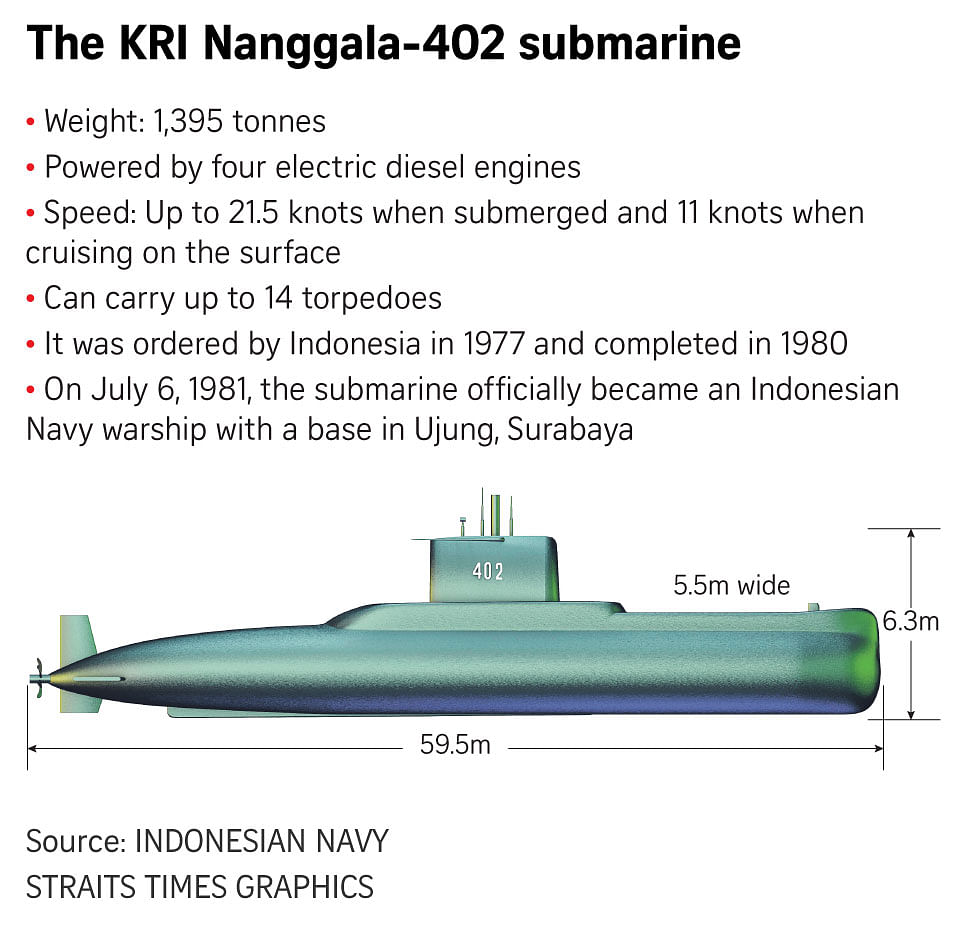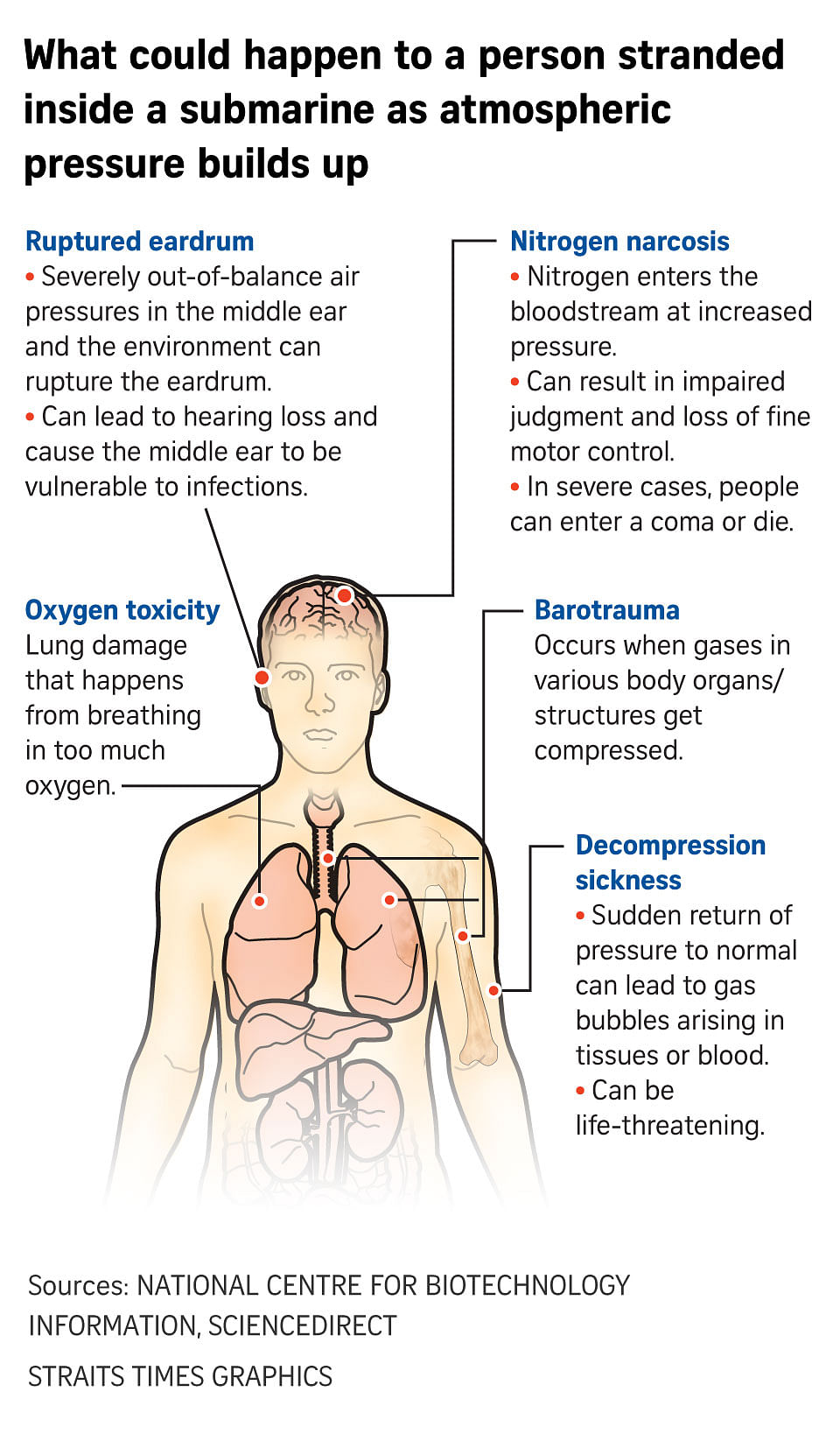Missing Indonesian submarine expected to run out of air at 3am Saturday: Navy chief
Sign up now: Get insights on Asia's fast-moving developments
Follow topic:
SINGAPORE - Indonesian Navy Chief Yudo Margono said on Thursday (April 22) that oxygen supplies onboard the vessel would last 72 hours from the time the submarine went missing, which means that they would run out of air around 3am on Saturday.
“We lost contact (with the vessel) yesterday at 3am, so it can last until Saturday 3am,” he told a news conference.
A maritime expert told The Straits Times on Thursday that the chances of survivors being found on the submarine that went missing in waters off Bali are slim.
The deeper the vessel is situated, the greater the pressure experienced by the sailors trapped inside the submarine, Indonesia's National Maritime Institute executive director Siswanto Rusdi said.
"The best-case scenario is that the crew suffered severe injuries such as burst eardrums and blood vessels, and the worst-case scenario is that they are dead," he added.
Contact with the Nanggala-402 vessel, with 53 crew members on board, was lost in the early hours of Wednesday during a torpedo-firing drill and a search for the submarine is ongoing, with vessels from Singapore and Malaysia called in to help.
President Joko Widodo said on Thursday that he had instructed the Indonesian military chief, Indonesian navy chief, Indonesia’s search and rescue agency and other relevant institutions to “deploy all resources and make a concerted effort” to search the submarine and rescue its crew.
“The priority is the safety of the 53 crew of the submarine,” he said in a live-streamed statement from Bogor state palace.
So far, there has been no trace of the missing submarine and no indication of an attempt by the crew to launch an emergency exit manually.
"If they had done so, modern warships and aircraft equipped with sonar capabilities would have been able to pick up the signal. But until now, we have yet to hear of such activity," Mr Siswanto said.
Even if the crew were able to exit the submarine, only a few could be let out each time, he added.
However, Mr Siswanto noted that the sonar capability of rescue ships could be impeded by the very nature of submarines - stealth vessels designed to be undetectable under water.

The media has reported that the missing submarine could have sunk as deep as 700m, exceeding its maximum depth of 500m.
"What this means is the pressure was so great that the hull of the vessel could have been damaged. Survivors, if any, could have suffered broken bones, and other hyperbaric injuries," Mr Siswanto said.
"The environment underwater is very challenging for both the vessel and the crew," he said.
Mr Siswanto said the disaster was in all probability due to the old age of the vessel, which was ordered by the Indonesian government from Germany in 1977. It was completed in 1980 and the vessel joined the Indonesian fleet in 1981.
A majority of Indonesian warships are over two decades old, he said, adding: "Usually submarines are retired after 20 to 25 years, but this submarine is double the age. No matter how much you try to repair, it's no use."
"It's akin to asking a 70-year-old grandfather to pull a rickshaw. He can't go any faster."
The most important task now is to locate the submarine, but with strong currents in Bali waters, both upstream and downstream, the submarine could shift position.
Once the missing vessel is located, a crewless submarine and divers will be deployed, with the submarine forced open to locate the crew within.
Singapore's MV Swift Rescue vessel, which is equipped with a Deep Search and Rescue Six (DSAR 6) submersible craft, could be asked to help, said Mr Siswanto.
The DSAR 6 is able to plunge into the water depths, attach itself to a crippled submarine, rescue its occupants and take them back up to the ship, where personnel trained in hyperbaric medicine can treat them.
Mr Siswanto expressed regret over the incident, saying that the Indonesian government should not have allowed old vessels to operate as they posed a major safety risk to the crew.
"It's a time bomb waiting to happen," he said.


